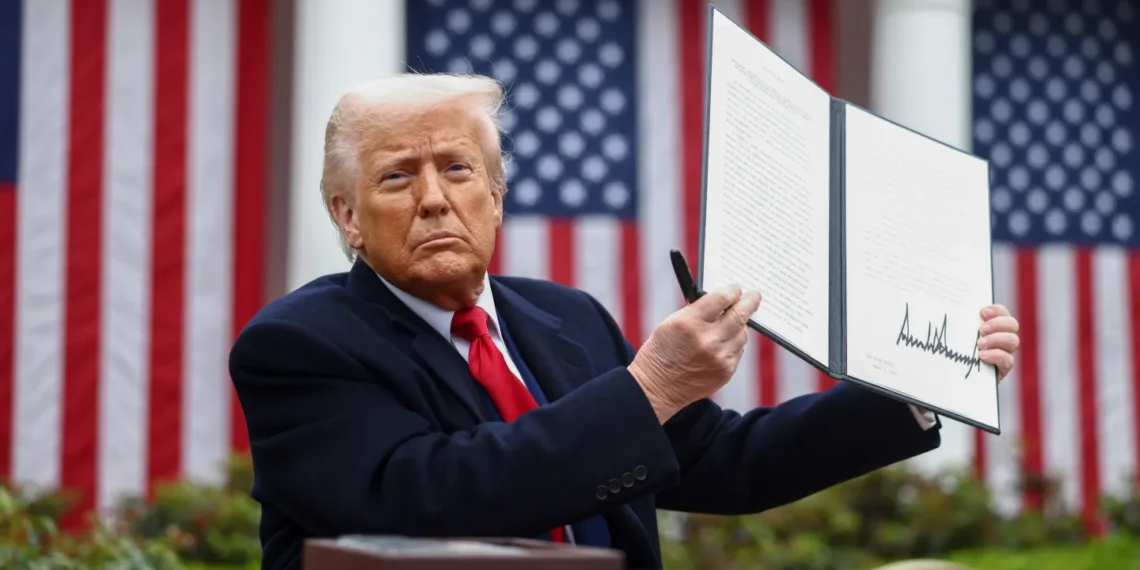On April 2, 2025, President Donald Trump signed an executive order in the White House Rose Garden, calling it “Liberation Day” for America. The order set tariffs on imports from nearly every country trading with the U.S. A 10% tariff now applies to all imported goods, while major trading partners like China, Japan, and Europe face rates between 34% and 54%. Three days later, on April 5, the policy is already making waves. For Illinois, a state tied to global trade, these tariffs could bring changes to the economy, gas prices, and stock market activity.
Illinois relies heavily on trade, especially with Canada, China, and Mexico. In 2023, the state imported $127.8 billion worth of goods from these countries, according to the Illinois Department of Commerce and Economic Opportunity. Canada alone sent $65.6 billion in goods, mostly oil and gas, which made up 72% of those imports. China shipped $43.9 billion, including $27.2 billion in computers and electronics. Mexico provided $18.3 billion, with $5.9 billion in beverages like beer and $2 billion in transportation equipment like car parts. The new tariffs could raise costs for these goods, affecting businesses and shoppers across the state.
The tariffs might push companies to make more products in the U.S., including Illinois. During Trump’s first term, steel tariffs in 2018 boosted demand for American steel, helping companies like Nucor, which has a plant in Bourbonnais, Illinois. Now, with tariffs hitting a wider range of imports, industries like manufacturing could see growth. Illinois has a strong manufacturing base—think cars in Belvidere or machinery in Peoria. If firms like Ford or Caterpillar shift production from abroad to the U.S., factories in Illinois could hire more workers. In 2018, steel tariffs added about 12,000 jobs nationwide, and a similar bump could happen here, though it takes time to build or expand plants.
Gas prices in Illinois could feel the squeeze too. The state gets most of its oil and gas from Canada—$47.4 billion worth in 2023. The 25% tariff on oil imports from places like Venezuela might not hit Canada directly, but a separate 10% tariff on Canadian energy could nudge prices up. Right now, on April 5, 2025, gas in Illinois averages $3.30 a gallon, higher than the national $3.20. During Trump’s first term, gas prices fell to $2.50 a gallon by 2020, thanks to a focus on U.S. energy. If American oil production rises, Illinois might see prices drop, but Canada’s response matters. If Canada retaliates with tariffs on U.S. exports, it could complicate energy flows, since Illinois sent $3.2 billion in food and metal products to Canada in 2023.
The stock market has been shaky since the tariffs were announced. On April 3, the Dow dropped 1,150 points, a 2.7% fall. The S&P 500 lost 3.14%, and the Nasdaq fell 4.13%. By April 4, the S&P 500 gained 0.4%, and the Nasdaq rose 0.9%. In October 2024, the S&P 500 was at 5,800, and the Dow hit 42,000. Today, they’re at 5,600 and 41,500—down 200 and 500 points, respectively. Illinois investors, especially in Chicago’s financial hub, are watching closely. Companies like Boeing, with a big presence in Chicago, rely on global supply chains. Tariffs could raise costs for parts, affecting stock prices.
Back in Trump’s first term, markets followed a similar path. In 2018, after tariffs on China, the S&P 500 fell 6% in a month. By January 2021, it climbed to 3,800, up 68% from 2,260 when he started. The Dow rose from 19,800 to 31,000. Illinois stocks tied to manufacturing and energy, like Caterpillar or Exelon, could see ups and downs now too. This week, energy stocks ticked up slightly, but tech and retail stocks dipped. Illinois’ trade gap—importing more than it exports—mirrors the U.S.’s $1.2 trillion deficit in 2024. Tariffs aim to shrink that gap, but it’s a slow process.
Illinois’ economy could face higher prices for imported goods. Electronics from China, like phones or laptops, might cost more at stores in Springfield or Rockford. Beer from Mexico, popular in Chicago bars, could see price hikes too. Car parts from Mexico, used by Illinois auto plants, might push vehicle costs up. During the 2018 tariffs, some prices rose, but U.S. manufacturing picked up. Today, the 10% base tariffs began on April 5, with higher rates starting April 9. Businesses are figuring out how to adjust, and some might pass costs to customers.
Trump’s team says the tariffs will bring in $6 trillion over time, possibly funding tax cuts or debt reduction. Illinois, a top exporting state in the Midwest, could benefit if that money boosts infrastructure or jobs. But other countries are pushing back. China plans tariffs on U.S. farm goods like soy, which Illinois exports heavily—$1.5 billion in 2023. Europe might target Illinois machinery or chemicals. In Trump’s first term, China’s retaliation hit Midwest farmers, though federal aid helped. Similar trade-offs could play out now.
The tariffs stem from Trump’s “economic independence” speech on April 2. He pointed to his first term, when unemployment dropped to 3.5% by 2020 and the economy grew before the pandemic. Illinois’ unemployment was 4.1% then, and manufacturing jobs ticked up. Today, the state’s economy is tied to trade—fourth in U.S. exports. The 10% tariffs aim to level the playing field, but they could disrupt supply chains. For example, Illinois imports $27.2 billion in electronics from China. If companies move production here, places like Schaumburg could see tech growth, but it’s not instant.
Three days in, the tariffs are just starting to hit. Gas prices might rise if Canada’s energy costs increase, though U.S. oil could offset that. Stocks are wobbly—down from October 2024 but not crashing. Jobs could grow in manufacturing, but only if companies invest in Illinois plants. In 2018, steel tariffs took months to show results, and this broader policy might too. China and Europe’s responses could hurt Illinois exports, like soy or machinery, worth billions yearly. Trump’s team says it’s about long-term gains, pointing to past growth.
Illinois’ trade ties make it sensitive to these changes. Canada’s $65.6 billion in imports dwarf other partners, and oil drives that. Mexico’s beer and car parts, China’s electronics—all face new costs. The stock market’s dips this week echo 2018, but the recovery then suggests potential. Gas at $3.30 a gallon could dip if U.S. energy ramps up, or rise if trade tensions grow. Jobs might increase, but prices could too. In Trump’s first term, early chaos led to gains—Illinois will see if that happens again.
On April 5, 2025, Illinois is at a crossroads. The tariffs are rolling out, with 10% hitting today and higher rates soon. Stocks are off October highs but stable compared to past drops. Gas prices and jobs hang in the balance, tied to how trade shakes out. The state’s $127.8 billion in imports from Canada, China, and Mexico now cost more, and exports could take a hit. Trump’s first term showed growth after turbulence—whether Illinois sees that repeat is still unfolding.








